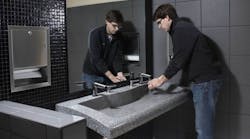How Unclean Restrooms Impact Students’ Perceptions of Your School
As high school students across the country prepare for the start of another school year, a new survey finds that some won’t be happy with the cleanliness of their institution’s restrooms.
The stats are a part of the Healthy Hand Washing Survey, which finds that nearly half of American high school students describe the condition of their school restrooms as “poor or fair.” The survey, conducted by commercial washroom solutions company Bradley Corp., aims to examine high school students’ perceptions of school restrooms.
Key Insights
The survey polled 630 9th- through 12th-graders and revealed that unclean school restrooms can cause them to have negative perceptions of their school and its leaders.
Notable statistics include:
- Nearly 50% of students rate the condition of their school restrooms as “poor or fair”
- 68% of students say school restrooms that are poorly maintained or unclean show the school doesn’t care about its students, reflects poor school management and lowers their overall opinion of the school
- 32% of students don’t use a school restroom because it’s usually dirty or smelly
- 57% of students are more likely to wash their hands when reminder signs are posted—only 34% of schools post reminder signs
“The negative impact of poorly maintained school restrooms is clearly significant and spreads beyond the bathroom doors to the entire school,” says Jon Dommisse, director of strategy and corporate development for Bradley Corp., in a press release. “Female students are even more inclined to be negatively influenced by run-down school restrooms.”
Bradley Corp.’s survey also asked students asked about how their school restrooms can make improvements. Their suggestions include:
- More privacy. Students would prefer taller stall doors and no gapping between the stall panels.
- Air fresheners. Foul odors are the No. 1 thing that bothers students the most about their school restrooms, according to the survey.
(Courtesy of Bradley Corp.)
Students’ Hand-Washing Habits
The survey finds that students don’t wash their hands after using the school restroom because there was no soap or paper towels available, they didn’t have enough time between classes, and the sinks weren’t working or were dirty.
Students also revealed that germs are a big worry. They believe the most contaminated surfaces are toilet flushers, stall door handles and the floor around the toilet. Some students even flush toilets with their foot (instead of their hand) on the flusher. A third of students polled say they use a paper towel to open the door.
Tips to Keep Your School Restrooms Clean
1. Organize restroom cleaning steps from cleaner surfaces to dirtier ones to minimize contamination of germs from one area to another, says Dommisse.
2. Pre-clean surfaces. Remove debris and soiled matter first then use a U.S. Environmental Protection Agency-registered product that eliminates contagious and hard-to-kill pathogens—such as MRSA, influenza and norovirus—to disinfect surfaces.
[Related: Dwell Time: Are Your Disinfectants Actually Working?]
3. Don’t forget to wipe away water drips on walls, especially those near hand-drying fixtures. Use a general glass and surface cleaner to remove water marks, soils and streaks on mirrors.
4. Change cleaning cloths frequently, Dommisse adds, and don’t use cloths used in one restroom in another location to minimize cross contamination.
5. Use microfiber cleaning cloths. They tend to provide better absorbency than cotton or rayon, Dommisse says.
6. Regularly stocking toilet paper, soap and paper towels will help promote regular hand-washing and proper restroom usage.
7. Use air fresheners or air purifiers to help keep unpleasant odors at bay.
8. Implement touchless fixtures to reduce germ touchpoints. “These fixtures help users avoid touching restroom surfaces, reduce the transmission of germs and bacteria from users’ hands, and improve overall hygiene as users leave the restroom area and enter other parts of the building,” Dommisse explains.
He adds that touchless fixtures are also easier for facilities staff to clean and maintain compared to traditional fixtures’ handles, levers and buttons. “With their simplified design and hidden mechanicals, [they] also tend to be tougher for vandals to manipulate and break,” Dommisse says.
9. Post hand-washing reminders near hand-washing areas. As mentioned earlier, the survey found that students were more likely to wash their hands if reminders are posted in the restroom. Dommisse adds that facilities staff should also wash their hands regularly—after using the restroom, emptying trash containers, or touching used paper towels and tissues.
As students head back to class across the country, know that your restrooms can make or break an impression—not just of the facilities staff, but of the institution itself and its leaders.
Read these next:



